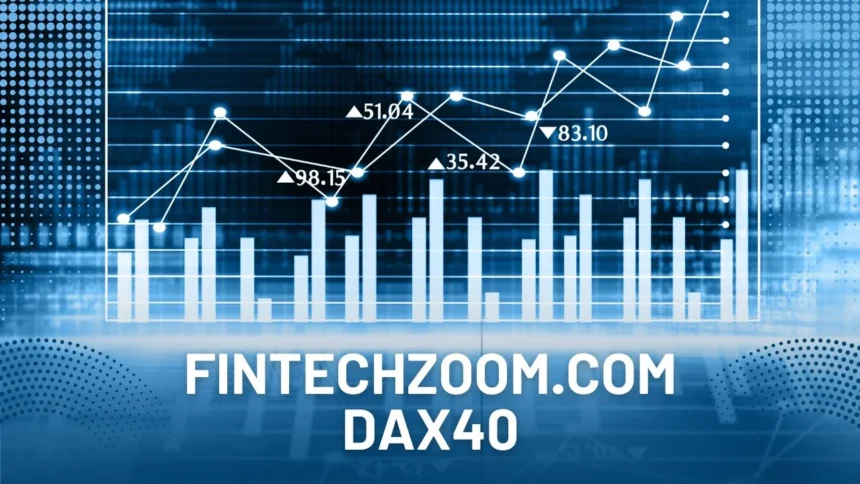If you’re looking to navigate the exciting world of investing, understanding market indices is crucial. One index that stands out in Europe is the DAX40. With its robust performance and diverse range of companies, it has garnered significant attention from investors worldwide. But what exactly is fintechzoom.com DAX40? This guide unpacks everything you need to know about this influential index, offering insights into its history, top companies, and how it can fit into your investment strategy. Whether you’re a seasoned investor or just starting out, there’s valuable information here for everyone interested in tapping into the potential of the DAX40. Let’s dive in!
What is Fintechzoom.com DAX40?
Fintechzoom.com DAX40 refers to a stock market index that represents the 40 largest and most liquid companies listed on the Frankfurt Stock Exchange. It’s an extension of the traditional DAX30, which included only 30 major players.
The shift to DAX40 reflects Germany’s dynamic economy and its increasing number of influential corporations. This broader scope provides investors with diverse options across various sectors.
Tracking this index gives insights into the overall health of Germany’s economy, making it a benchmark for both domestic and international investors. With companies ranging from automotive giants to innovative tech firms, fintechzoom.com DAX40 encapsulates significant trends in Europe’s financial landscape.
Investors often use this index as a tool for gauging market sentiment while also gaining exposure to leading German enterprises. The growth potential here is substantial, attracting attention from those looking to capitalize on European markets.
History and Background of the Index
The DAX40, which stands for Deutscher Aktienindex 40, traces its origins back to the late 1980s. Initially, it started as a representation of the top 30 German companies in terms of market capitalization. As Germany’s economy evolved and grew stronger within Europe, so did the index.
In September 2021, it expanded from 30 to 40 constituents. This change aimed at providing a more comprehensive view of the German stock market landscape. The shift also reflected an increasing number of significant players in various industries.
With this expansion came greater diversity among sectors represented, allowing investors broader exposure to technology, finance, and consumer goods. Today’s DAX40 serves as a crucial barometer for both domestic and international investors looking to gauge Germany’s economic health and performance on a global scale.
The Top Companies in the DAX40
The DAX40, an index representing 40 major German companies, showcases a diverse range of sectors. Among the most prominent players is Siemens AG, a leader in technology and engineering. Their innovations drive efficiency across various industries.
Another key company is Volkswagen AG. This automotive giant has made strides in electric vehicles, reflecting the industry’s shift towards sustainability.
Bayer AG stands out as well, particularly in pharmaceuticals and biotechnology. Their commitment to research fuels advancements that impact global health.
On the tech front, SAP SE shines with its software solutions tailored for businesses worldwide. Its focus on cloud computing positions it strongly for future growth.
Allianz SE represents the financial sector robustly. As one of Europe’s largest insurers and asset managers, they play a vital role in risk management strategies globally. Each of these firms contributes significantly to the DAX40’s dynamic landscape.
Performance and Trends of the Index
The DAX40 index has shown remarkable resilience in recent years. As Germany’s premier stock market benchmark, it reflects the performance of 40 major corporations. These companies are influential players, driving both domestic and global economies.
Throughout various economic climates, the DAX40 has displayed volatility but maintains a general upward trajectory over time. Investors often look to this index for insights into broader market trends in Europe.
Recent performances have been characterized by strong recoveries post-pandemic. Many sectors within the index, such as technology and renewable energy, have outperformed expectations. This shift highlights an evolving landscape where innovation is at the forefront of growth.
Trends indicate a growing interest in sustainable investments among investors worldwide. The DAX40 is not just about traditional industries anymore; emerging markets are gaining traction too. Keeping an eye on these changes can provide valuable opportunities for savvy investors looking to diversify their portfolios.
Benefits and Risks of Investing in DAX40
Investing in the DAX40 can be a lucrative opportunity for many. One significant benefit is exposure to established German companies, which often have strong fundamentals and a global presence. This index represents a mix of sectors, offering diversification within your investment portfolio.
However, risks are inherent in any market. Economic fluctuations or geopolitical tensions could impact the performance of these stocks significantly. Additionally, being heavily weighted towards specific industries may amplify volatility during downturns.
Investors also need to consider currency risk when investing from outside the Eurozone. Changes in exchange rates can affect returns unfavorably if not managed properly.
Before diving into DAX40 investments, weighing these factors is crucial. Balancing potential rewards with associated risks will help you make informed decisions tailored to your financial goals and risk tolerance.
Tips for Investing in DAX40
Investing in the DAX40 requires a strategic approach. Start by researching each company on the index. Understanding their business models, market positions, and performance trends can give you an edge.
Diversification is crucial. Avoid putting all your money into a single stock within the DAX40. Instead, spread your investments across multiple sectors to mitigate risk.
Keep an eye on economic indicators that impact the German economy. Factors like inflation rates and employment figures can influence stock performance significantly.
Consider using stop-loss orders to protect your investment from sudden downturns. This strategy helps limit potential losses without requiring constant monitoring of market fluctuations.
Stay informed about global events that may affect Germany’s economic landscape. Political shifts or international trade agreements can have ripple effects on stocks in the DAX40 portfolio.
Conclusion
Investing in fintechzoom.com DAX40 presents both opportunities and challenges. Understanding the index’s history, composition, and performance trends is crucial for making informed decisions. With a diverse range of companies spanning various sectors, DAX40 offers potential growth prospects.
However, it’s essential to weigh the benefits against the risks involved. Market volatility can impact investments significantly, so having a clear strategy is vital. By staying updated on market trends and company performances within the index, investors can navigate this landscape more effectively.
As you consider your investment journey with DAX40, remember to diversify your portfolio and conduct thorough research. This approach will help mitigate risks while capitalizing on potential gains from one of Europe’s leading stock indices.







